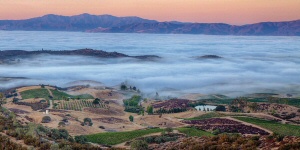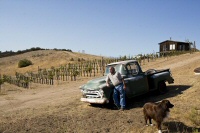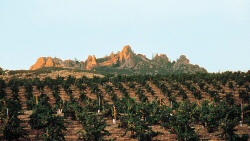
Although Monterey County’s Santa Lucia Highlands is a hot appellation on a global scale these days, it was another growing area of our County that actually first captured the world’s attention. It was also a wine produced from this AVA that was the first to be considered superior to French wines in a now famous blind tasting in the 1970s. This particular California Chardonnay was not from Napa Valley, as most people would assume. It was from Monterey County, and it was from Chalone.
As you probably already know, Chalone is one of our County’s appellations, but it’s one that doesn’t seem to receive as much attention as it should. There are a few reasons contributing to this unfortunate reality. With only about 300 planted acres of vines, it’s a fairly small growing area. Additionally, after the unfortunate closure of Chalone Vineyard’s tasting room some years ago, the AVA lost its only tasting room. And there aren’t many possibilities for another tasting room to open to begin with, as there are only a small number of growers or wineries in the appellation, and a good amount of the grapes grown in Chalone end up being made into wine by out-of-County wineries.
Furthermore, this is not the easiest area to reach. It is located high in the Gabilan Mountains east of Soledad, 1,500 to 1,800 feet above the Salinas Valley, at the base of Pinnacles National Park. Anyone who’s driven to the Pinnacles may have had a similar first impressions, as most, when suddenly seeing grape vines stretching alongside the winding road leading to the park. The impression is most likely something along the lines of: people actually grow grape vines up here?
For those who have not been on Route 146, the reason one would question the choice to plant grape vines here is that after ascending from the fertile valley, the landscape dramatically changes into high desert conditions. Ironically though, it’s actually precisely because of these conditions that such premiere and sought-after fruit is produced by these vines. This is a truly unique soil environment where decomposed granite, volcanic soils, and limestone are all co-located. This combination gives wines from Chalone distinct mineral qualities that some describe as flinty.
 Despite the challenging terrain and conditions (it gets scorching hot in summer), the first commercial vineyards in Monterey County were planted there in 1919. In fact, the oldest producing vines in the County are located there. In the 1950’s, wine grape production in Chalone began to blossom, with the original owner selling fruit to larger wineries, such as Wente. In the 1960s, Sonoma County wine pioneer Rodney Strong was even involved with Chalone. Despite the challenging terrain and conditions (it gets scorching hot in summer), the first commercial vineyards in Monterey County were planted there in 1919. In fact, the oldest producing vines in the County are located there. In the 1950’s, wine grape production in Chalone began to blossom, with the original owner selling fruit to larger wineries, such as Wente. In the 1960s, Sonoma County wine pioneer Rodney Strong was even involved with Chalone.
But it wasn’t until a banker looking for a life-change decided to become a winery owner in 1965 that Chalone really started coming into its own. That former banker was Richard Graff, and he changed Chalone forever. The culmination of this vision was on full display when a Chalone Chardonnay was selected over Chardonnays from Burgundy in the event known as the 1976 Judgment of Paris. It may have been a Cabernet Sauvignon from Napa County that won biggest that day, but it was a Chardonnay from Monterey County right alongside it to share in the newly-discovered American winemaking glory. From that time on, Chalone has been considered a premiere wine growing area.
But some of the banker in him must have stuck around, as the winery then known as Chalone Vineyard became the first in the U.S. wine industry to go to an IPO in 1984. However, despite what were most likely his great intentions, the opening up of the winery’s ownership also most likely led to a demise in its quality. In 2004, the once small, independent winery which was a figurehead for an entire AVA, was bought out by a corporate giant.
That giant liquor company, Diageo, once again instigated a major change for the Chalone Vineyard winery which may have resulted in repercussions which, albeit wrongly, may have led to a slight degradation of the overall AVA. Diageo would eventually change the face of the Chalone Vineyard winery by expanding away from only estate-grown fruit and small production, as had been the Chalone tradition for decades, to large-scale production and sourcing from outside the AVA.
 However, perhaps there is a change in the air once again. Chalone Vineyard winery is currently for sale…so who knows what comes next for this storied winery and the greater Chalone AVA. All of us engaged in Monterey County’s wine industry have our fingers crossed that someone will step in and turn things around to get Chalone Vineyard back to its former glory. However, perhaps there is a change in the air once again. Chalone Vineyard winery is currently for sale…so who knows what comes next for this storied winery and the greater Chalone AVA. All of us engaged in Monterey County’s wine industry have our fingers crossed that someone will step in and turn things around to get Chalone Vineyard back to its former glory.
There are other growers and small wineries in the ChaloneAVA who have endured and continue growing and producing excellent grapes and wines from Chalone. Antle and Michaud Vineyards wineries produce excellent wines with every new vintage, such as Antle’s Mourvedre included as one of our March Club selections. Pinot Noirs and Chardonnays are still grown there, as they have been for almost a hundred years. The are other varietals grown in the Chalone AVA have a reputation for being outstanding as well. Chenin Blanc, Pinot Blanc, Syrah, Marsanne….if you see any of these varietals with the Chalone AVA on their label, you will not be disappointed. |